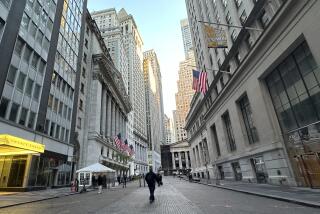Economy Fuels Stocks
- Share via
Stocks soared Friday as “Enronitis” worries faded on the heels of more evidence that the economy is back on a solid growth track.
The Dow Jones industrial average jumped 262.73 points, or 2.6%, to 10,368.86, its highest close since Aug. 27.
The technology-dominated Nasdaq composite, which has been hammered in recent weeks, rebounded 71.25 points, or 4.1%, to 1,802.74. It was Nasdaq’s biggest one-day gain since Dec. 5, and was led by semiconductor stocks.
The blue-chip Standard & Poor’s 500 index rose 2.3%, also the biggest gain since Dec. 5.
Market pros said fresh data Friday on the manufacturing sector and on consumer spending ended the debate for many investors on whether the economy is in recovery mode after last year’s slump.
“Today everyone is a believer that the economic recovery is real,” said Philip Orlando, chief investment officer at Value Line Asset Management in New York.
Despite increasing signs this year that economic activity was rebounding, Wall Street’s powerful fourth-quarter rally gave way to heavy profit-taking in many stocks in January and February.
The market has been under pressure in part because of investors’ concerns that the failures of Enron Corp. and Global Crossing Ltd. could be followed by many more corporate collapses tied to illegal or improper accounting.
But those fears took a back seat Friday to excitement about a turn in the economy that could revitalize corporate earnings.
“Recovery is the future. Enron is the past,” said Al Goldman, veteran market strategist at brokerage A.G. Edwards in St. Louis.
Though some analysts say that view may be underestimating the potential for more firms to be caught in accounting controversies, buyers were aggressive Friday. And unlike in recent sessions, when stocks rallied early in the day only to fade in the afternoon, Friday’s surge gained steam in the final half hour of trading.
Beaten-down tech shares led the rally. Intel surged $2.43 to $30.98 and the SOX semiconductor stock index leaped 11%. Other tech winners included IBM, up $4.90 to $103.02, and Veritas Software, up $3.71 to $39.20.
Many consumer-related stocks were strong, including Procter & Gamble, up $2.76 to $87.55, and Target, up $1.25 to $43.15. Home builders’ shares also were hot.
Trading was active, but far from record levels. Likewise, market breadth--the ratio of rising stocks to falling stocks--wasn’t as strong as the gains in key indexes might imply. Winners topped losers by 22 to 9 on the New York Stock Exchange and by 23 to 12 on Nasdaq. On dramatic turnaround days on Wall Street, winners often outnumber losers by 3 to 1 or 4 to 1.
With Friday’s gains the Nasdaq index was up 4.5% for the week--snapping a four-week losing streak--while the S&P; 500 rose 3.9% and the Dow was up 4%.
Still, among major indexes only the Dow is in positive territory this year, with a gain of 3.5% since Dec. 31. The Nasdaq is down 7.6% and the S&P; index is off 1.4%.
The rally’s ability to sustain itself in the first few days of next week will be a key test, some experts said. If buyers continue to pour back into the market, a rebound could become self-fulfilling by pulling in more investors who have been sidelined this year.
Buying by “short sellers” also could help power the market higher. With near-record levels of stocks sold short--meaning borrowed and sold in a bet on declining prices--a rising market would force more short sellers to buy stocks to close out their bets.
But late Friday, software giant Oracle provided a reminder that companies’ struggles aren’t over: The firm warned that its earnings in the quarter just ended will be below expectations. Oracle shares, down 63 cents to $15.99 in regular trading, fell to $14.71 after hours.
Even so, some market pros say investors now have more reason to be bullish than bearish, with the economy seemingly on a sure growth track while short-term interest rates remain at 40-year lows.
Ed Keon, investment strategist at Prudential Securities in New York, said the average price-to-earnings ratio of blue-chip stocks is about 20 based on estimated operating earnings for 2002.
Though investors still may be nervous about earnings estimates given accounting concerns, Keon said the market isn’t overvalued, and is more appealing than many alternatives, such as money-market funds paying annualized yields of less than 1.5%.
Long-term interest rates could pose a challenge for Wall Street, however, some analysts warn.
Treasury bond yields surged Friday. Bond investors’ fear is that a robust recovery could drive long-term yields sharply higher. The 10-year T-note yield rose to 4.98% Friday from 4.88% Thursday.
Market Roundup, C6-7
More to Read
Inside the business of entertainment
The Wide Shot brings you news, analysis and insights on everything from streaming wars to production — and what it all means for the future.
You may occasionally receive promotional content from the Los Angeles Times.










